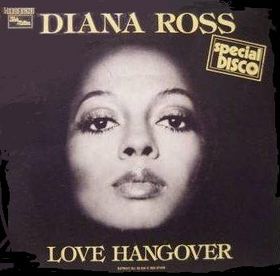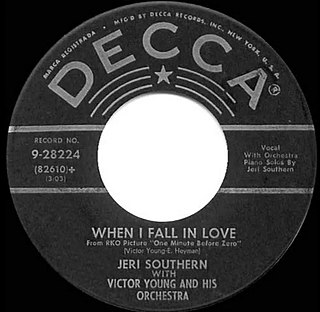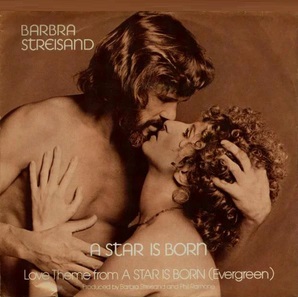
Concetta Rosa Maria Franconero , known professionally as Connie Francis, is an American pop singer, actress, and top-charting female vocalist of the late 1950s and early 1960s. She is estimated to have sold more than 100 million records worldwide.

Connie Stevens is an American actress and singer. Born in Brooklyn, New York City to musician parents, Stevens was raised there until age 12, when she was sent to live with family friends in rural Missouri after she witnessed a murder in the city. In 1953, at age 15, Stevens relocated with her father to Los Angeles, California.

The Lettermen are an American male pop vocal trio whose trademark is close-harmony pop songs with light arrangements. The group started in 1959. They have had two Top 10 singles, 16 Top 10 singles on the Adult Contemporary chart, 32 consecutive Billboard chart albums, 11 gold records, and five Grammy nominations.

"Love Hangover" is a song by the Motown singer Diana Ross, recorded in 1975 and released as a single on March 16, 1976. It rose to number one on the Billboard Hot 100 and Hot-Selling Soul Singles. It also hit number one on the Record World disco charts.
"You Always Hurt the One You Love" is a pop standard with lyrics by Allan Roberts and music by Doris Fisher. First recorded by the Mills Brothers, whose recording reached the top of the Billboard charts in 1944, it was also a hit for Sammy Kaye in 1945.

"Itsy Bitsy Teenie Weenie Yellow Polka Dot Bikini" is a novelty song telling the story of a shy girl wearing a revealing polka dot bikini at the beach. It was written by Paul Vance and Lee Pockriss and first released in June 1960 by Brian Hyland, with an orchestra conducted by John Dixon. The Hyland version reached number one on the Billboard Hot 100, selling a million copies in the US, and was a worldwide hit. The song has been adapted into French as "Itsy bitsy petit bikini" and into German as "Itsy Bitsy Teenie Weenie Honolulu-Strand-Bikini", reaching number one on national charts in both languages. Several versions of the song have proved successful in various European countries. In 1990 a version by British pop band Bombalurina, titled "Itsy Bitsy Teeny Weeny Yellow Polka Dot Bikini", reached number one on the UK Singles Chart and in Ireland.

"When I Fall in Love" is a popular song, written by Victor Young (music) and Edward Heyman (lyrics). It was introduced in the film One Minute to Zero as the instrumental titled "Theme from One Minute to Zero". Jeri Southern sang on the first vocal recording released in April 1952 with the song's composer, Victor Young, handling the arranging and conducting duties. The song has become a standard, with many artists recording it; the first hit version was sung by Doris Day released in July 1952.

"Hold Me, Thrill Me, Kiss Me" is a song written by Harry Noble and originally performed by Karen Chandler in 1952. It has been re-recorded several times since then, the most notable covers being by Mel Carter in 1965 and Gloria Estefan in 1994.

"Angel of the Morning" is a popular song written by Chip Taylor, originally recorded by Evie Sands but which first charted with a version by Merrilee Rush. The song has been covered by many artists including Chrissie Hynde, Dusty Springfield, P. P. Arnold, Connie Eaton, Mary Mason, Guys 'n' Dolls, Melba Montgomery, Olivia Newton-John, Bettye Swann and most recognizably by Juice Newton.

"Evergreen" is the theme song from the 1976 film A Star Is Born. It was composed and performed by American singer, songwriter, actress and director Barbra Streisand with lyrics by Paul Williams, and arranged by Ian Freebairn-Smith. The song was released on the soundtrack album to A Star Is Born.
"Dedicated To The One I Love" is a song written by Lowman Pauling and Ralph Bass that was a hit for the "5" Royales, the Shirelles, the Mamas & the Papas and Bitty McLean. Pauling was the guitarist of the "5" Royales, the group that recorded the original version of the song, produced by Bass, in 1957. Their version was re-released in 1961 and charted at number 81 on the Billboard Hot 100.
"Why" is a hit song recorded by Frankie Avalon in 1959. It reached No. 1 on the U.S. Billboard Hot 100 chart published on the week of December 28, 1959. It was Avalon's second and final No. 1 hit.
"Wedding Song (There Is Love)" is a title of a 1971 hit single by Paul Stookey: the song—which Stookey credits to divine inspiration— has since been recorded by many singers (with versions by Petula Clark and Mary MacGregor returning it to the Billboard Hot 100)—and remains a popular choice for performance at weddings.

Where Is My Castle is the fifteenth solo studio album by American country singer Connie Smith. It was released in January 1971 via RCA Victor and contained ten tracks. The album was described as a set of a traditional country songs and were considered to be autobiographical of Smith's life at the time. The disc's title track was released as a single in 1970 and reached the top 20 of the North American country charts. The album itself would chart in the top 40 of the American country LP's chart. Following its release, Billboard magazine gave it a positive review.

I Got a Lot of Hurtin' Done Today / I've Got My Baby on My Mind is the twenty-fourth solo studio album by American country singer Connie Smith. It was released in January 1975 and contained 11 tracks. It was also considered to be one of her "most commercially-successful" discs of the decade, according to biographer Barry Mazor. Three singles were included on the project. Both "I've Got My Baby on My Mind" and her cover of "Why Don't You Love Me" reached the top 15 of the American country songs chart. "I Got a Lot of Hurtin' Done Today" would chart in the top 30. The album itself reached the American country LP's chart in early 1975. Billboard gave the album a positive review following its release.

"Stupid Cupid" is a song written by Howard Greenfield and Neil Sedaka which became a hit for Connie Francis in 1958.

"Lipstick on Your Collar" is a song written by Brill Building staff writers Edna Lewis (lyrics) and George Goehring (music) which was a 1959 hit single for Connie Francis.

"So Sad (To Watch Good Love Go Bad)" is a song written by Don Everly, which was released by The Everly Brothers in 1960. The song was later a country hit for multiple artists in the 1970s and 80s.
"Kookie, Kookie " is a song written by Irving Taylor and performed by Edward Byrnes and Connie Stevens. The single was produced by Karl Engemann and arranged by Don Ralke, and was featured on Byrnes' 1959 album, Kookie Star of "77 Sunset Strip".
The discography of American singer Connie Stevens includes numerous studio and compilation albums, and 20 singles. Stevens first garnered success in 1960, when her hit song "Sixteen Reasons" peaked at number 3 on the Billboard Hot 100 and number 9 on the UK Singles Chart. She was first heard as the female voice on the 1959 hit song from Edd Byrnes, "Kookie, Kookie ".













